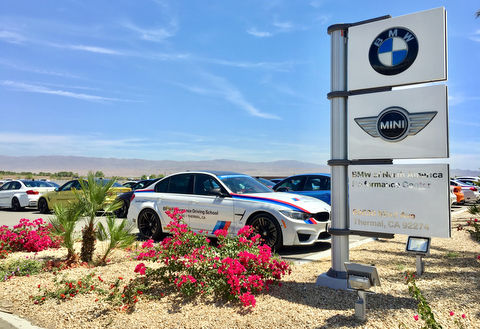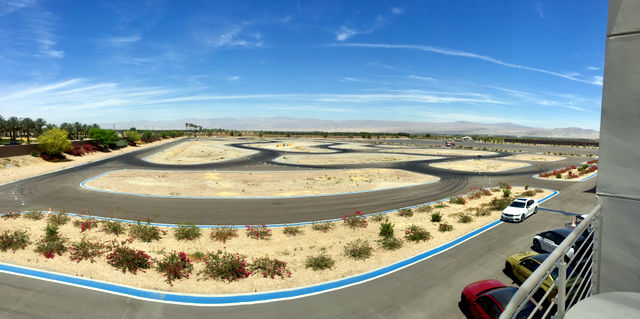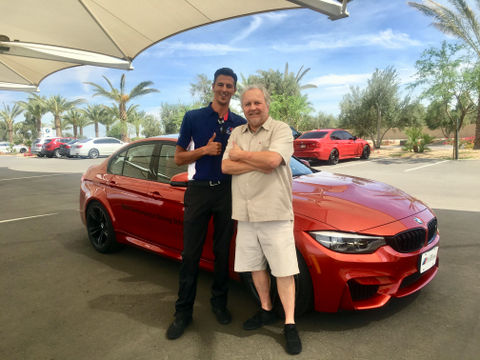Maximizing Fuel Economy Can Be Fun
Clean Fleet Report knows your interest in cars goes far beyond commuting and vacations. CFR readers are familiar with technology, motorsports, design trends and, of course, vehicles that get great fuel economy. The next dimension for cars is more about fun and lifestyle, as in what you can do with them, and how much you can get out of them.

Clean Fleet Report had the opportunity recently to visit the BMW Performance Center in Thermal, California. Located about 30 miles southeast of Palm Springs, the BMW Performance Center sits on the grounds of The Thermal Club, a private ownership motorsport club and resort community. If you are ever in the Coachella Valley, go check it out, it will be worth your time.
Our goal was to learn how BMW goes about maximizing fuel use through technology and driving techniques. Our host for the day was Adam Seaman, senior instructor lead of the BMW Performance Driving School. To get started, we addressed how performance driving and fuel economy are not mutually exclusive because, as everyone assumes, driving fast and hard is a fuel burner. BMW calls it “Learn to drive on the edge of physics.” We later got a chance to put these theories into action out on the track.
Clean Fleet Report: BMW’s have fuel efficiency gauges on them. Is there an approach to driving that maximizes efficiency?
BMW: Of course. All BMW models have efficient modes, in addition to the Sport modes. In the efficiency modes they automatically adjust such things as the throttle response, throttle curve and the power application. They also adjust the engagement of the torque converter, which in my 340i company car, the converter is disengaged when rolling at speed on the freeway. Every BMW has the stop/start feature, so when you pull-up to a stop light, the engine turns off, then re-starts automatically as well.
CFR: Whether it is racing or on city streets, what does BMW recommend for being the most efficient driver?
BMW: A big part of driving is your vision and paying attention. So, looking way ahead and realizing when you can lift to let the car coast and when you can start applying brakes a little earlier. In addition to those is being smooth with your inputs, such as throttle application and, believe it or not, picking the proper line through a corner.

Vision comes into play when getting onto the freeway on entry ramps, as you can use momentum instead of raw power to get up to speed. Recognizing these will affect your fuel economy. Again, [the key is] paying attention and looking up will help with all these things.
CFR: It seems there are some basic and common sense fuel saving tips from a racetrack that can easily be transferred to street driving.
BMW: There are. As a racer, it is knowing when to apply the throttle to stay ahead of your competitor. When to shift and use the brakes the most efficiently. This is the same for on the highway and around town.
What Does Premium Fuel Do?
CFR: Do all BMW’s run on premium fuel? And if so, what happens when regular is used?

BMW: Yes, they all run on premium, or 91 octane. They can run on regular, but we do not recommend it. Ultimately, it will affect your fuel [economy] because the lower the octane level, the more apt it is for the fuel to have pre-detonation, which will eventually kill your fuel [economy] as well as your engine.
CFR: Conversely, if a car is built for regular, or 87 octane, will this car get better performance or fuel economy by running premium?
BMW: No, they will not get better fuel economy, and it works the other way around too. What you get with a lower octane level and a higher compression engine is that under compression and heat, that fuel can pre-detonate before the piston is at top dead center. This could cause engine failure, or on the lower end, less fuel economy and less performance.
CFR: When driving a manual shift car, say with six speeds, is it bad to be in fifth or sixth gear at 35 miles per hour, trying to save fuel?
BMW: It depends on what type of vehicle you are in. I have played around with that in several of my cars and feel that for the average driver being in the efficient modes is great. But I always drive in the Sport mode and found I get better fuel economy than when in an efficient mode. I find that, in the Sport mode, I do not have to push as hard on the accelerator to try to get it up to speed. Also, taking in account something like turbocharged vehicles, when you are under a heavy load you are producing more boost, which in turn requires more fuel. So, if you are in fifth gear at a low speed [and want to accelerate hard], you would use more boost and fuel as opposed to dropping down to fourth so the engine is under a lighter load.
Turbochargers and direct injection have done tremendous things for fuel economy in cars, since about 2007 when more and more manufacturers began introducing both into their vehicles. This technology has come a long way, and it helps us out greatly as we don’t have to go the extra mile to get good fuel economy.
CFR: We commonly see people driving on the highway with their windows down, thinking it is more efficient than with them up and using the air conditioner (A/C). It has been proven that whatever horsepower draw comes from running the A/C is less than the increased wind resistance by having an open window at 70+ mph.
BMW: If I had to estimate, the horsepower draw by running the A/C is maybe less than 5-percent. BMWs are great in the respect that the compressor automatically disengages at 90-percent throttle so, if you do need power, it gives it to you.
Electrification & Diesel
CFR: Have you driven any of BMW’s cars that have electrification?

BMW: I have, and BMW has done a great job with the technology in the i8 by blending the gasoline engine with the electric motor. Obviously, there is Formula E, so there is a future for it in motorsports. It is just a matter of letting the technology catch up with the need to do it, or move in that direction.
CFR: And lastly, what about BMW diesel-powered cars?
BMW: At one point the 3-Series diesels were in the BMW driving schools, and they were fantastic. They were awesome little cars with lots of torque that were really fun to drive out on the track and, overall, people loved them. The average driver doesn’t drive their car to redline on the street, as they just go from stop light to stop light, staying around that 3,000-5,000 rpm range. And that vehicle is perfect for that and is where it really shines.
Related Stories You Might Enjoy—More BMW News & Reviews
Personal: Behind the Wheel at the BMW Performance Center
News: BMW iX3 Electric Crossover Coming to US in 2020
News: BMW Electrification Push Bearing Fruit
Road Test: 2017 BMW i3 Electric
News: BMW To Announce All-electric 3-Series
News: BMW Adds iPerformance Electrics
Road Test: 2016 BMW 328d xDrive Sports Wagon
First Drive: 2015 BMW i8

3 thoughts on “Interview: BMW Driving Tips: Performance & MPG”